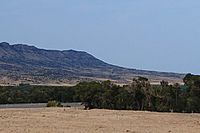Fort Parker facts for kids
Fort E.S. Parker was the very first agency for the Crow Indians in Montana. It was built in the fall of 1869. This fort was named after Ely S. Parker. He was a Seneca lawyer who worked for President Ulysses S. Grant. Parker also became the Commissioner of Indian Affairs.
The fort was created because of the Fort Laramie Treaty of 1868. This treaty closed the Bozeman Trail to travel. It also said that the Crow people needed a new main center, or "agency," on their land. The first idea was to build it near where Big Timber is now. But it ended up being built about eight miles east of Livingston in 1869.
Contents
Life at Fort Parker
The first Crow Indian Agency worked from 1869 to 1875. Then it moved further east. It eventually found its final home at Crow Agency in 1884.
Thomas Leforge, who was a white man living with the Crow, said the fort was sometimes called the "Mission Agency." This was because many Indian agencies back then were set up where Christian missionaries were already working. But this wasn't true for Fort Parker. However, a Methodist minister named James Wright did try to start Christian lessons there in 1873.
Building the Fort
The fort was built on a high cliff, about 40 to 60 feet above the valley. A creek called Mission Creek flowed just east of the fort. The fort also looked out over the Yellowstone River, which was about half a mile away.
The fort was made from square-cut logs and had a shingle roof. It had buildings for storing supplies and living spaces. These were for the agent, doctor, engineer, miller, carpenter, blacksmith, and school teacher. It also had two guard towers called bastions. The agency buildings burned down on October 30, 1872. They were quickly rebuilt using adobe bricks, because wood was becoming hard to find.
Leaders at the Agency
L.M. Black, a businessman from Bozeman, was the first temporary Crow Agent. Major E.M. Camp took over in October 1869. After him came David Pease, a respected businessman. He spoke two Native American languages and was married to a Crow woman.
Dr. James Wright, a Methodist minister, took over from Pease in August 1873. Dexter Clapp, a former army officer, replaced Wright just before the agency moved east. In the early 1870s, the agency was often a place for travelers to stop on their way to explore Yellowstone National Park.
Purpose of the Fort
The main reason for building Fort Parker was to give out supplies to the Crow people. It also aimed to encourage the Crow to start farming. However, it was a tough place for farming. There were strong winds, cold weather, and large buffalo herds nearby.
Some non-Native Americans, like fur trappers and the Indian Agent F.D. Pease, married into the Crow Tribe. The agency also helped protect the people of Bozeman and the Crow. It guarded them from attacks by the Sioux, Cheyenne, and Blackfeet tribes.
The Fort Moves East
Fort Parker was left empty in 1875. This happened even though the Crow people and locals from Bozeman didn't want it to move. They knew moving further east would put them closer to areas controlled by the Sioux.
Just before the move to Rosebud Creek, near Absarokee, a group from Bozeman called the Bozeman Grange sent a letter. They supported the Crow and the agency on the Yellowstone River:
...it is a known fact that the Crow Indian tribe is as helpful as a whole army in the Gallatin Valley. When they are on their Reservation, no attacks are made by enemy Indians. The settlers feel safe and secure... if the Agent would fairly give out the supplies and spend the money given, there would be no problem keeping the Indians on their reservation."



